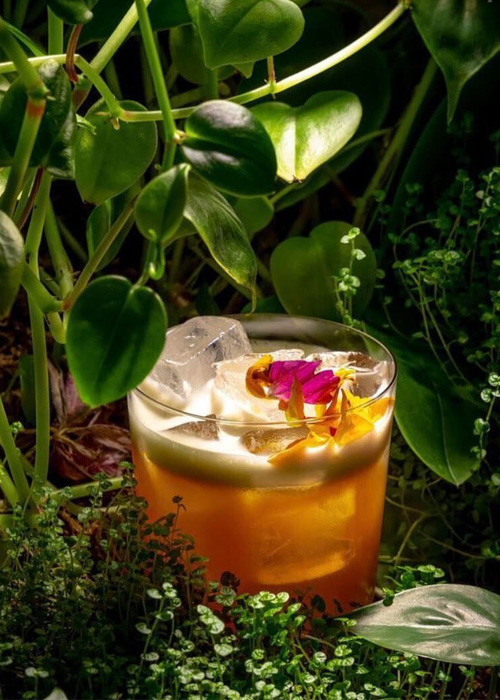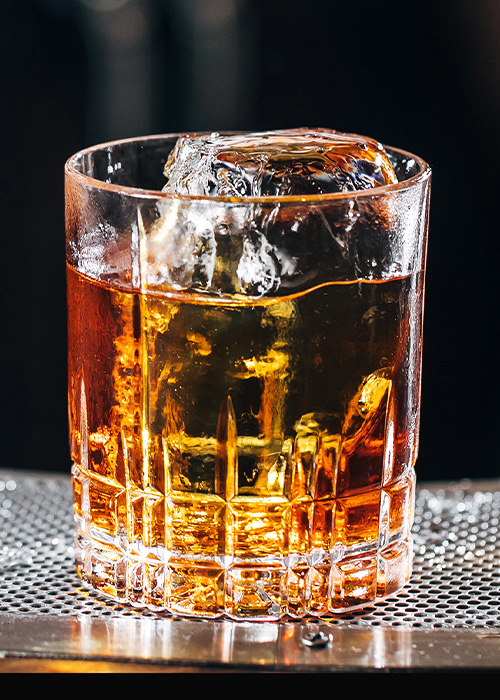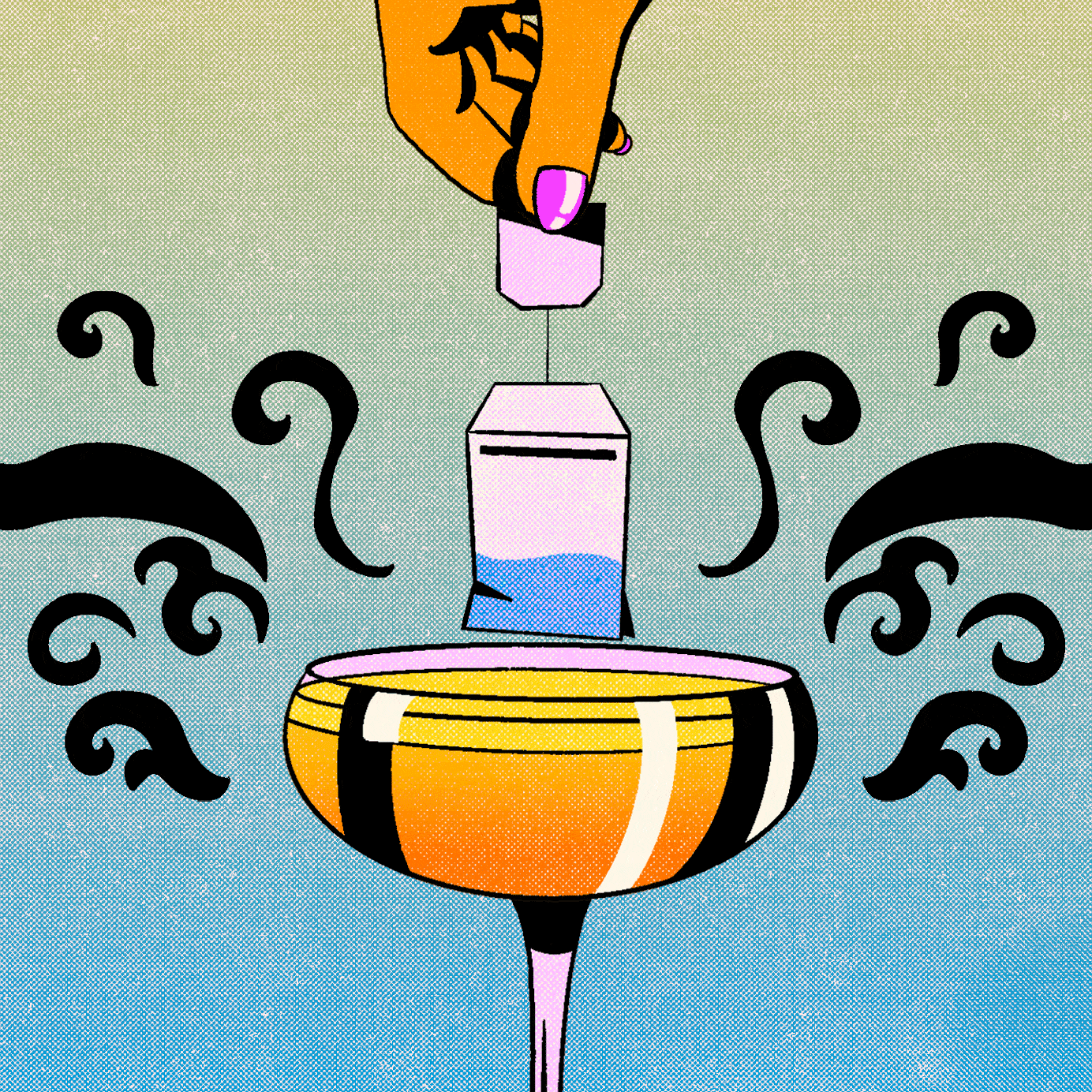When Channing Centeno, creative beverage director at Bonnie’s, a new Cantonese restaurant in Williamsburg, Brooklyn, started planning the restaurant’s drinks menu, he knew tea would play a major role. “Tea is a big part of Cantonese culture and I would go to Chinatown a lot and visit the tea and coffee shops, called cha chaan tengs, to sample the menu and find flavors to bring into the cocktails,” he says. He saw orange pekoe tea at tea shops and hibiscus and butterfly pea in desserts.
These flavors made their way onto the menu in surprising ways, like the yuen yeung Espresso Martini (yuen yeung means half and half), a twist on the Espresso Martini. Centeno uses half tea and half coffee; the orange pekoe is “over-brewed to an American palate, so it offers a lot of tannin. It’s pretty unique because it has a very strong tea flavor, and we sell a ton of them,” Centeno says.
Another tea-based menu highlight was developed in a flash. On the restaurant’s second night, chef-owner Calvin Eng’s friends from the Shy Boyz Club, who love Long Island Iced Teas, were dining at Bonnies, and Eng asked Centeno to make them one with five minutes’ notice. The rest is history. “I whipped something together; people saw us serve it on Instagram and came in and asked for it,” Centeno says. “It’s a large-format drink and we serve it in a teapot, which is cheeky.”
The Long Island Iced Tea uses a multitude of spirits, including Hennessy, Mexican Coca-Cola, and a lemon honey iced tea base that’s also part of a non-alcoholic drink, which Centeno likes to treat “like regular cocktails.” Inspired by a tea commonly served at cha chaan tengs, he created a tea concentrate and built the drink around it so it wasn’t just an iced tea with honey and lemon. “It’s more dry,” he says.

When pairing teas and spirits, Centeno really likes black tea with Scotch, floral teas with vermouth, and agave spirits with green tea. To discover new flavor combinations, he recommends going to a tea shop, smelling different teas, and thinking about what the end goal is. “If you smell the chamomile tea and smell honey, then I like grapefruit with honey, and I like grapefruit with tequila,” he says. And just like that, a cocktail is born.
At Bonnie’s, the customer response to the tea-focused cocktail menu has been encouraging. “A lot of bartenders are scared to lean into the effects of over-steeping or using a lot of tea and trying to be way too subtle with it because of bitter and tannic notes,” Centeno says, noting that people actually tend to like those flavors in cocktails. He points to a perfect example on the menu at Undercote, the beloved Koreatown speakeasy from Cote, which uses Casa Dragones tequila, orange, grapefruit, and Korean red ginseng tea. The ginseng adds welcome tannins and a frothy texture.
Downtown, at the Dead Rabbit, beverage director Jillian Vose uses tea in the Black Rose, which blends Tullamore Irish whiskey infused with Earl Gray tea, dry Curaçao, walnut, and amaro. The flavor profile is inspired by an Old Fashioned, with the Curaçao lending an orange caramel flavor. Vose has an Irish mother who “loves a nice cuppa,” but she began working with tea and appreciating its nuances in a previous role at Death & Company. For those looking to dive into the world of tea, she recommends Henrietta Lovell’s book “Infused: Adventures in Tea.”

When she started at the Dead Rabbit in 2014, the Black Rose was one of the first drinks she added to the menu. Vose prefers creating infusions or tinctures with tea, adding the leaves directly to spirits for a brief period and then straining the mixture, which creates a highly concentrated flavor. Infusions of this sort can oxidize, which isn’t a problem at a high-turnover bar like the Dead Rabbit, but it’s something to keep in mind if you make them at home.
To make tea-based cocktails at home, Vose recommends buying leaves from T Salon in Kingston, N.Y., Rare Tea in London, and In Pursuit of Tea for online shopping. Once you’re stocked up, however, do not follow package instructions. “Look at the brewing instructions and double or triple it. Use double the amount of tea, double the steeping time, and reduce the amount of water,” Centeno explains, noting that this will result in a more concentrated flavor. At cha chaan tengs, tea is passed through a sieve sometimes up to seven times — a process Bonnie’s tries to replicate to extract more tannins.
To truly unlock a tea’s flavor profile, Vose recommends a tea tasting, which many shops can set up. “It opens your mind to how you can use it in cocktails. If you blind taste a whiskey, you take note of all the things you smell and all things you taste. You do the same thing with coffee, with beer, with a spirit,” says Vose. “Treat tea the same way.” Paying attention to tea’s flavor profiles helps pair it with the right spirits and ingredients — and the possibilities are endless.

